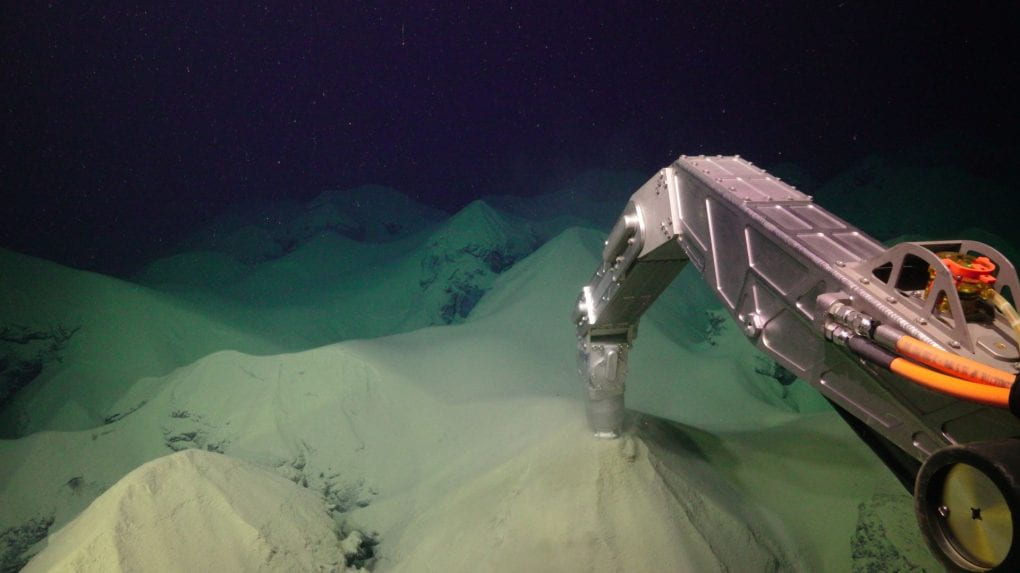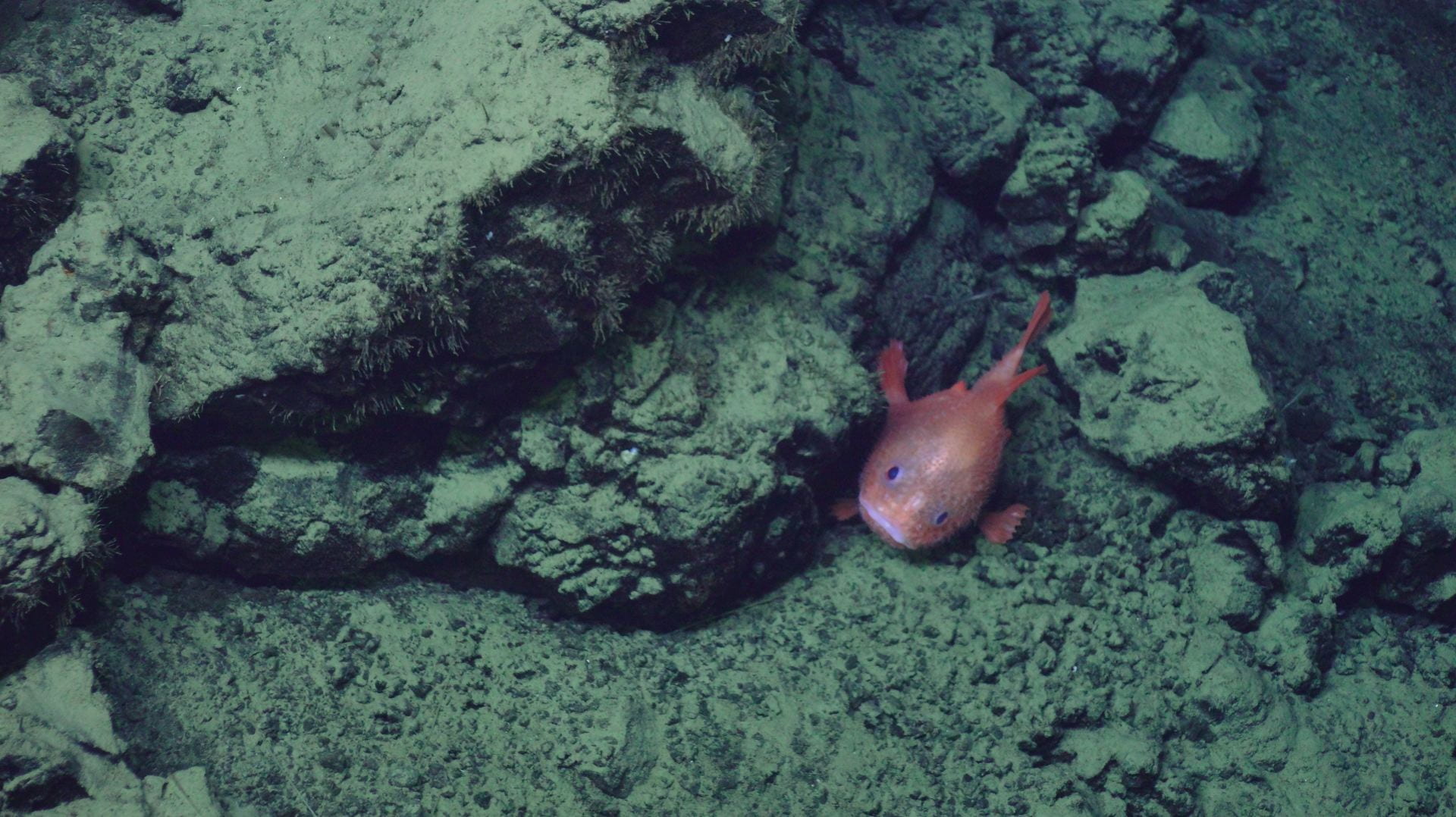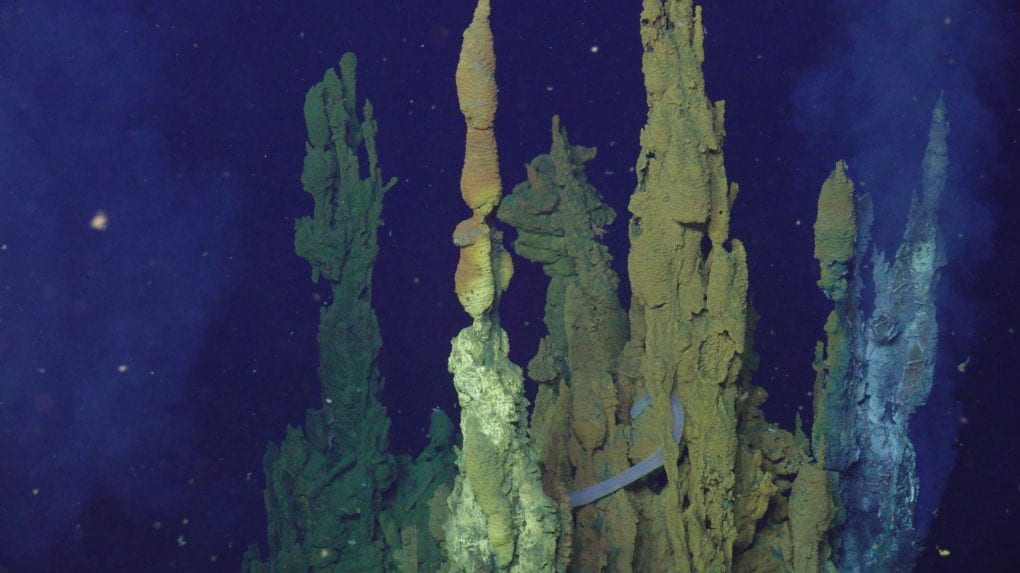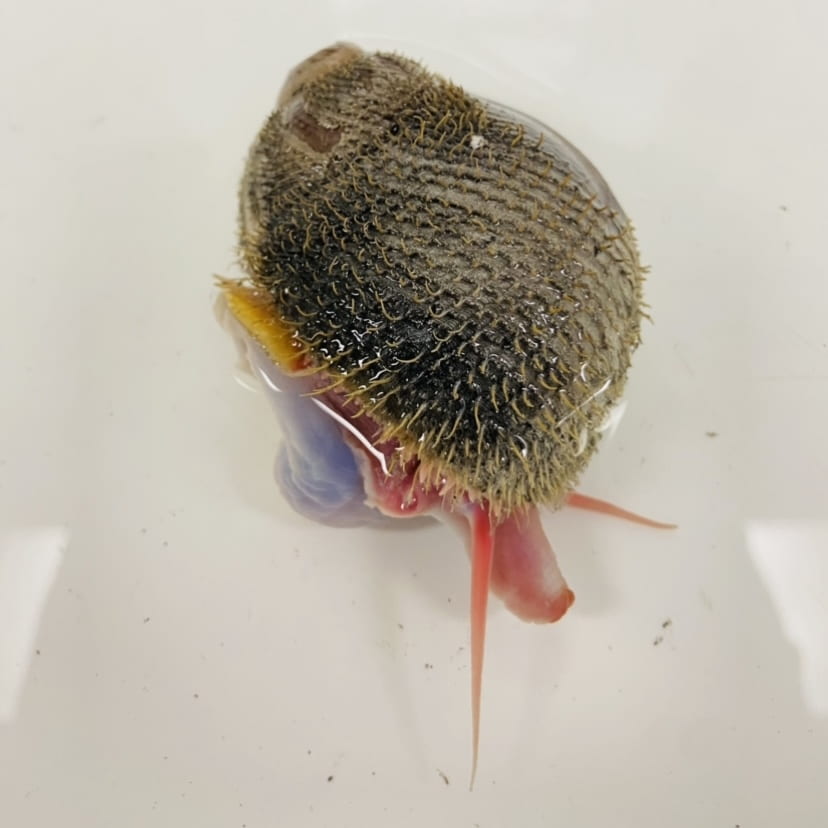April 20th, 2022. The science team is now on the second round through conducting science at our six sites in the Lau Basin. While we’ve already been out at sea for almost a month and we’ve still got 3 weeks to go! The time between each of these sites has varied between 35 minutes to 8 hours. Sometimes we would get a nice break between samples collected from Jason and Sentry. Other times we would have a quick turn around and would need to sleep in shifts to get samples processed in time. Even the transit from our southernmost site, Mariner, back to our northernmost site, Kilo Moana, was only 12 hours! Now it’s time to do it all over again. Although this time, we now know how all our sites look, and where the good collection locations are.
I want to walk you through some of the sights we’ve seen so far. When we first arrived, the first thing we saw at our sites were not snails, but instead was what we presumed was ash! Since we are so close to the Hunga Tonga Hunga Ha’apai volcano, we are assuming that this could be from the recent eruption. We’re currently communicating with some geologists in Tonga and around the world to collect observations and samples. The depth has varied across and between sites, but at Kilo Moana one of the manipulator hands on Jason disappeared completely into the ash. The ash turned our rocky sites into snow-capped mountains. At first, we were worried that all vent animals were covered. As we further explored our sites, we found concealed refuges of resilient snails. Here’s a photo at ABE, our biggest site, of a group of chimneys covered in Ifremeria nautilei, Alviniconcha sp., and some vent crabs. One thing to notice is at the apex (the smallest whirl / point of the shell) of many of these snails it’s white where the shell has broken off. It’s tough living at the bottom of the ocean on rocky volcanoes!
This next photo takes us to another site, Tu’i Malila that was very mountainous. Throughout the dive we were surrounded by huge walls of basalt with diffuse, weak, flows of vent fluid. These pockets of hydrothermal energy were inhabited by groups of animals, like these Alviniconcha strummeri here. If you look closely towards the center of the image you can actually see the shimmering water that indicates these diffuse flows mixing with the seawater. This site had many patches like this, some snail patches surrounded by groups of Bathymodiolin mussels, creating a nest-like appearance. At this site we also found many creatures peering out from between the rocks like this curious little pink sea toad.




The final site I’ll show you this time is from our final site, Mariner. This site, while active (has flowing vent chimneys), does not host our study snail species. This site will act as a control group to collect background vent data (looking for symbionts / larvae) in a place without snails. While devoid of snails, this site has some of the most spectacular vent chimney structures. Chimneys towering over 15 meters, one called the toilet bowl, “black smokers” – chimneys spewing heavy metal rich hydrothermal fluid, in all sorts of shapes. Here’s a photo of the spiky top of one of these chimneys, where you can see the irregular shape that they form in. You might also notice the long purple organism wrapped inside, which happens to be a sea cucumber! This site still had many different types of organisms, just not the snails we are studying on this snail cruise. Here’s another photo of a rock we found covered in these beautiful puffball / lollipop sponges. These little dandelion-looking creatures are actually a type of carnivorous sponge. Those long spicules radiating from the center act as a net collecting passing plankton that can be consumed by the individual. In the bottom left corner there’s also a small squat lobster.


While we’ve been enjoying our time at sea, seeing fantastical habitats in an unfamiliar world, working with amazing scientists, and getting to use frontier scientific instruments, we are disconnected from our daily lives. This past week we missed Easter, usually a time to spend with family, so we celebrated on board. We brought candy and easter eggs that we placed all around the ship. Hidden under microscopes, within coffee mugs in the galley, and within storage cabinets. If an egg was found it would be re-hid with new contents, creating a constant easter egg hunt as we’re all awake and active at different times throughout the day. Everyone could participate. Timed with some maintenance on the ROV Jason, this gave us a fun break day to decorate Styrofoam cups instead of our traditional easter eggs. These cups will go down on the side of Jason or Sentry and will shrink under the pressure from a dive. Here’s a few of the ones we crafted.



Alviniconcha kojimai
Keeping up with the pattern from the last post, I’d like to introduce another of our study species, Alviniconcha kojimai. This was one of the first of our Alviniconcha sp. that we found on this expedition. As I introduce the rest of the snails from this group, you’ll see they look very similar to each other. There are a few ways to differentiate them, I prefer to do it through the spines on their periostracum (the outer shell layer). On kojimai between each of the tall spikes there are three smaller spikes. They also have the reddest coloration on their snout and cephalic tentacles (those long protrusions). This species is found in our more southern sites, where the geology is more andesitic and hydrogen sulfide concentrations in the vent fluid decrease. Whether these changes are impacting their distribution is one of the questions we are exploring.
anapolon max 50
References:
safe steroid for muscle building (https://sistemagent.com:8081/wilfredovigano)
KPV is beneficial in cutaneous wound therapeutic and different injury-related remedies by modulating immune responses and tissue restore.
Because of its anti-inflammatory properties,
KPV can profit skin situations like eczema,psoriasis, and dermatitis—especially when irritation is rooted
in gut or immuneimbalance. As research on peptide-based therapies for irritation and tissue restore continues to increase, making certain high-quality peptide sourcing
is important for correct and reproducible research outcomes.
New analysis on hormones on this class have show immunomodulating and anti
inflammatory results of these peptides. KPV has a multitude of uses on the auto-immune aspect as well as the
anti-inflammatory aspect. Relying on what the world that must be targeted, the route administered plays a large position.
The proposed mechanism involved focused supply of KPV to infected
colonic tissues, where it’d exert anti-inflammatory influence.
The findings advised that KPV may protect mucosal surfaces and downregulate TNF-α, a key
inflammatory marker. One of KPV’s most significant advantages are its
anti-inflammatory properties. It has been proven to inhibit the activation of NF-kappaB
and MAP kinase inflammatory signalling pathways and scale back pro-inflammatory cytokine
secretion [1]. This makes it a potential therapeutic agent for inflammatory bowel illness (IBD)
and different inflammatory conditions [1].
Unlike most peptides, a KPV dose may be administered not just via injection, but also orally in pill and spray form, or topically as a cream.
First, KPV has been discovered to exert extra pronounced anti-inflammatory activity than full-length α-MSH [3].
Alpha-MSH and derivatives like melanotan 2 are used in a big selection of contexts, together with sunless tanning, sexual problems, and sleep enhancement.
Research have additionally demonstrated α-MSH’s immunomodulating and anti-inflammatory results [2].
All of our content is written by people with a powerful science background, together with medical researchers.
Our objective is to give you essentially the most
scientifically accurate, unbiased, and comprehensive
data concerning all analysis peptides and SARMs.
The demand for peptides and blends extends beyond well being and health
to essential sectors like analysis and growth. Core Peptides
seems to grasp this market dynamic well, aligning their business ethos with offering
high-quality products to meet present market calls for.
Whereas peptide therapy and peptides themselves are safe, there are a
quantity of peptides that do pose a risk to
those who want to use them.
The anti-inflammatory impact of KPV is mediated via the transporter
PepT1. Efficacy, tolerability and security of cannabis-based medicines for
chronic pain management – An overview of systematic evaluations.
Effectiveness of different cryotherapies on ache and illness activity in active rheumatoid
arthritis. Here’s a synopsis of what you most likely already learn about signs and diagnosis in case you
are reading this text. Contemplating how rapidly the fungal infections develop resistance
against any current treatment. With KPV topical cream
there is a risk that the infectious pathogens might be eradicated.
This page may include sensitive or adult content material that’s not
for everybody.
Research continue to discover KPV’s antimicrobial results, especially its potential
in combating antibiotic-resistant bacterial infections.
Thymosin beta-4 (TB4) is a forty three amino acid, 5kDa polypeptide that is a
vital mediator of cell proliferation, migration, and differentiation. TB4 is essentially the most abundant member of the β- thymosin family in mammalian tissue and is regarded as the principle G-actin sequestering peptide.
Thymosin beta-4 is angiogenic and may promote endothelial cell migration and adhesion, and angiogenesis.
TB4 also accelerates wound healing and reduces irritation and scarring when utilized in dermal wound-healing assays.
From protein fruit drinks that fuel your healing course of to intestine peptides that assist your barrier perform, every bit
can help restore stability.
This allows KPV to be administered in several body areas with the next degree of safety
and efficacy. Given its robust anti-inflammatory properties,
KPV might be investigated for its potential advantages in other inflammatory and
autoimmune illnesses beyond the gastrointestinal tract.
KPV, derived from α-melanocyte-stimulating
hormone (α-MSH), has proven stronger anti-inflammatory action than its parent peptide.
This enhanced efficacy, coupled with its lack of notable unwanted aspect effects,
makes KPV a promising candidate for treating inflammatory
illnesses. In The Meantime, the consumer wouldn’t notice KPV’s advantages in the identical method
they might with a weight-loss or focus peptide, because
its results don’t manifest so visibly.
References:
https://music.magic-pics.tk/jvxretha58892
Sermorelin and ipamorelin are two peptide hormones that have
become popular among individuals seeking to enhance growth hormone production for various health and aesthetic purposes.
While each compound works independently, many practitioners
combine them in therapy protocols because they complement one another’s pharmacodynamics, resulting
in a more robust stimulation of endogenous growth hormone secretion with fewer side effects than high-dose growth hormone injections
alone. This article delves into the recommended dosages for both
peptides, outlines the benefits of using them together, and explains what makes sermorelin acetate unique compared to other
forms.
Ipamorelin/Sermorelin Dosage
When prescribing ipamorelin or sermorelin, clinicians typically tailor the dosage to an individual’s age, weight, baseline hormone levels, and desired outcome.
A standard starting point for most healthy adults is a 100–200
microgram dose per injection. The peptide can be administered once daily, usually in the morning before breakfast, as growth hormone release follows a circadian rhythm with peaks during sleep.
For patients who have experienced a plateau in benefits or
are undergoing a “tapering” phase, doses may be reduced to 50–75 micrograms per day.
In contrast, sermorelin is often dosed slightly higher because it mimics
the natural growth hormone-releasing hormone (GHRH) more directly.
Typical daily injections range from 300 to 600 micrograms,
split into two or three administrations throughout the day to mimic physiological pulsatility.
Some protocols recommend a “pulse” regimen of 200 microgram at bedtime and
400 microgram in the early afternoon; this pattern has been shown to stimulate growth hormone release
during both wakefulness and sleep.
When combining ipamorelin with sermorelin, practitioners usually
do not simply add the doses together. Instead,
they use a split protocol: for example, 200 micrograms
of ipamorelin at bedtime plus 300–400 micrograms
of sermorelin in the morning. This approach ensures that both peptides act synergistically while avoiding overstimulation of the pituitary gland.
It also allows clinicians to monitor side-effect profiles more accurately,
as each peptide has a distinct receptor affinity and half-life.
Benefits of Sermorelin and Ipamorelin Combination
Enhanced Growth Hormone Secretion:
Sermorelin stimulates the pituitary to release growth hormone by acting
on GHRH receptors, while ipamorelin targets the
ghrelin receptor (GHSR). Because these receptors are distinct, simultaneous activation leads to a greater overall surge in circulating
growth hormone than either peptide alone. In clinical studies, combined
therapy has produced increases of 200–300 percent over
baseline levels.
Improved Sleep Architecture:
Growth hormone is most effectively secreted during slow-wave sleep.
Sermorelin’s pulsatile release pattern aligns with natural nocturnal peaks, whereas ipamorelin’s longer half-life sustains growth hormone levels throughout
the night. The result is deeper, more restorative sleep,
which patients report as increased energy and better mood regulation.
Reduced Side Effects:
Both peptides are designed to be selective, minimizing stimulation of
other pituitary hormones such as prolactin or ACTH.
When used in isolation at high doses, growth
hormone-releasing hormone analogs can cause mild headaches
or fluid retention. The combination allows lower individual dosages while maintaining
efficacy, thereby lowering the risk of edema and arthralgia.
Facilitated Body Composition Changes:
Growth hormone promotes lipolysis and muscle protein synthesis.
Patients on combined therapy frequently notice a decrease in visceral fat and an increase in lean body mass over 3–6 months, even without drastic changes to diet or
exercise routines. The dual peptide approach provides
a more consistent anabolic stimulus that is easier to
maintain long term.
Safety Profile for Long-Term Use:
Because both ipamorelin and sermorelin do not directly supply exogenous growth hormone but instead trigger the body’s own production, they
have a lower risk of tumorigenesis or insulin resistance compared with direct GH injections.
The combination is therefore considered safer for prolonged therapeutic use under
medical supervision.
Understanding Sermorelin Acetate
Sermorelin acetate is the salt form used in most injectable preparations,
which improves its solubility and stability at physiological pH.
The “acetate” component refers to an acetyl group attached to the peptide chain, a
modification that protects the molecule from rapid enzymatic degradation once it enters systemic circulation. As
a result, sermorelin acetate has a half-life of approximately 15–20 minutes, long enough
to reach peak pituitary activation but short enough to avoid continuous overstimulation.
The acetate salt also influences how the peptide is reconstituted with sterile water or saline for injection. Clinicians
typically dissolve 5 milligrams of sermorelin acetate in 1 milliliter of sterile water, creating a solution that delivers 500 micrograms per
milliliter. This concentration allows flexible dosing: a patient may receive a 200-microgram dose from a 0.4-milliliter injection or a larger
600-microgram dose from a 1 week before and after dianabol.2-milliliter syringe,
depending on the therapeutic goal.
In addition to its pharmacokinetic advantages, sermorelin acetate’s specific sequence of amino acids ensures high affinity
for GHRH receptors while minimizing off-target interactions.
This selectivity is critical in maintaining the peptide’s safety profile; non-acetate forms or analogues with altered
sequences can sometimes trigger unwanted hormone release or immune responses.
In summary, combining ipamorelin and sermorelin acetate offers a powerful yet gentle method to boost endogenous growth hormone
production. By carefully adjusting dosages, timing injections to align with natural hormonal
rhythms, and utilizing the acetate form for stability, clinicians can maximize benefits such as improved sleep, body
composition, and overall vitality while keeping side effects to a minimum.
steroids that help you lose weight
References:
http://www.k0ki-dev.de
Then simply place an order by including it into the cart or just using
our customer service portal, and will most likely be delivered to you very quickly.
The intravenous use of steroid injection can help enhance your muscle mass by selling amino acid production,
nitrogen retention, and protein synthesis.
Inside a short time period, you’d expertise progress in your skeletal muscles.
It’s honest to say that the majority of individuals in this world will not understand
your desire to take or purchase steroids. It’s greater than probably as a end result of they’ve the incorrect outlook on anabolic steroids.
Possibly it’s as a outcome of they have a lack of know-how on what they’re and what they actually
do. Most Likely a result of being given incorrect data and being offered on the idea that steroids are a creation of the devil.
With clear Test E Cycle Dosage Chart tips and descriptions,
AAS Pharmacy aims to make each purchase clear and easy.
The site also prioritizes user privacy, offering secure fee methods and discreet
delivery options. We discover that Testo-Max is greatest used in bulking cycles, maximizing testosterone levels and mass achieve.
When considering where to buy steroids which might be legal, take into consideration the potential
dangers of scams and low-quality products. When in search of a reliable
legal steroids supplier, it is essential to ensure they have a user-friendly website with clean navigation and fast transport options, such as CrazyBulk or Brutal Drive.
Moreover, the supplier ought to have clear delivery insurance policies and
provide varied fee methods for a seamless and safe purchasing experience.
The incidence might be (very) low and a agency causal hyperlink has not been established.
In explicit, an affiliation between testosterone therapy and prostate cancer was shortly drawn based on animal experiments and limited case research (81).
Notably, the ventral prostate of the rat turned the mannequin organ for androgenic activity in the famend Hershberger androgen bioassay, which was developed in 1953 (82).
While a severely flawed approach, the bioassay stays in use at present, to some extent, within the quest for
selective androgen receptor modulators (SARMs) (83, 84).
Classification of a facet effects’ likelihood relies on expert opinion of the authors.
Our premium steroids and performance enhancers help speed up your fitness journey, permitting you to reach your targets sooner and
extra effectively. While anabolic steroids do not produce a excessive, it is
attainable to turn out to be hooked on them and feel dependent upon them.
Customers who really feel afraid to stop taking AAS medications or who discover themselves obsessing over them should
search assistance in drug addiction rehab. At the best drug
rehab facility, it is attainable to get clear from steroids and be
taught abilities to say no to them going ahead. They are offered at health meals stores,
in gyms, by huge box shops, and online by common and specialty
retailers.
More current well-designed trials continued to supply additional support for the potent muscle-building results of AAS that had already been acknowledged
by athletes for many years (15, 22, 35–38).
Orally ingested AAS are quickly absorbed within the gastrointestinal (GI) tract, with serum
concentrations peaking 1–2 hours after ingestion of methyltestosterone (8).
With Out structural modification to withstand first-pass metabolism, a big fraction of the absorbed AAS might be
metabolized earlier than leaving the liver and re-entering the circulation.
One of the principle causes that bodybuilders end up with
well being problems from steroid use is that they massively overdose on the
quantities. These Days the typical man on the road
takes their steroids in quantities that the Execs of ten years
would never have dreamed of taking! There’s no denying that Testosterone
is a great drug for muscle constructing.
Alandomestic ships packages from China and claims he’s delivery them home
within the USA. Moreover, he sells lots of faux and counterfeit
gear on this web site. The ZPHC model he carries has been identified to provide infections, damage and
hospital visits to users. Unreliable Sources,
while these sources are in the high 10 on the listing, they aren’t reliable and may
be scamming or selective scamming users. It’s onerous to say, so we put them at the backside of the listing
to be on the secure facet. The Food and Drug Administration (FDA) has released numerous warnings to consumers
to keep away from DMAA and its varied varieties
in OTC dietary supplements.